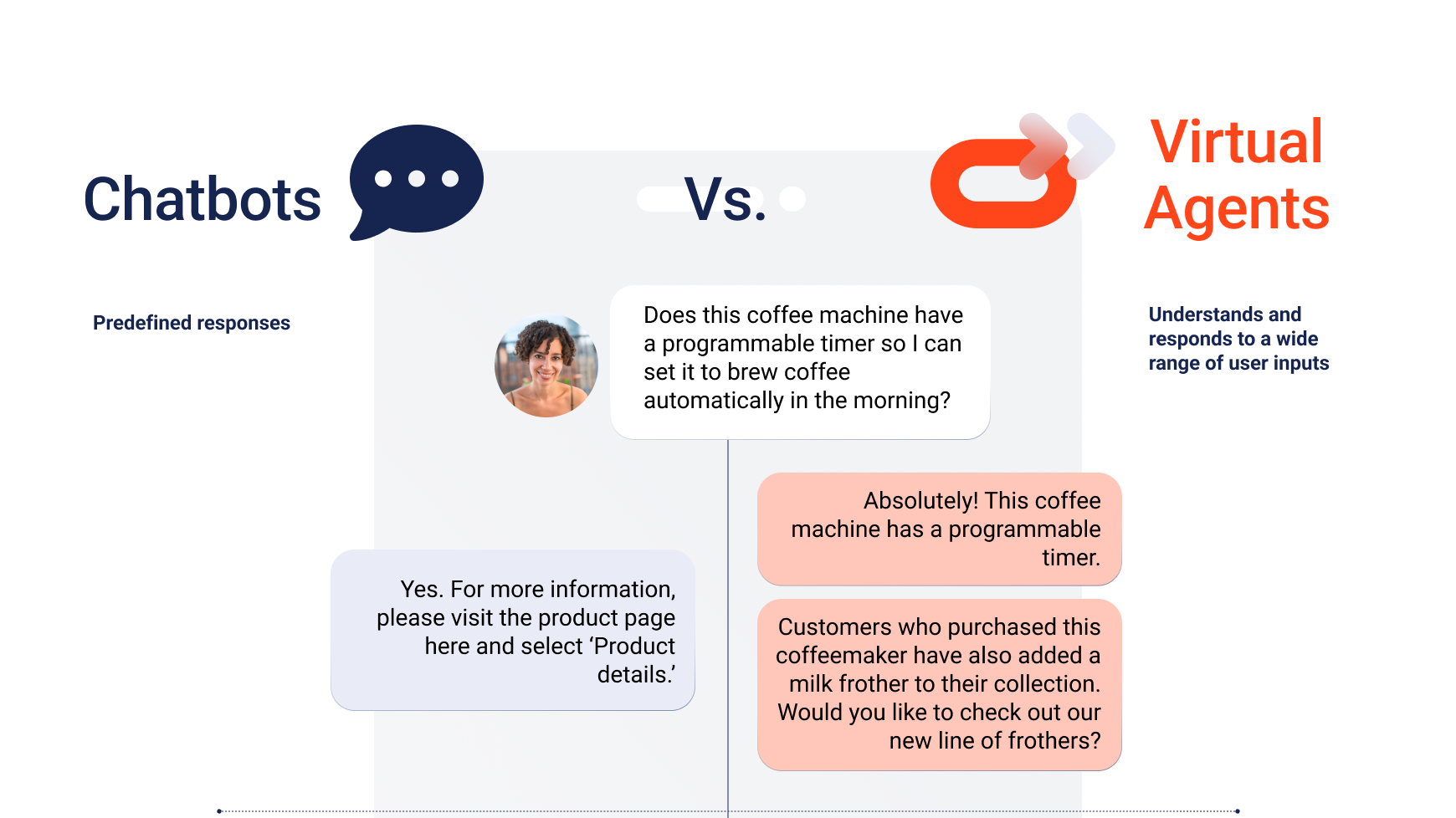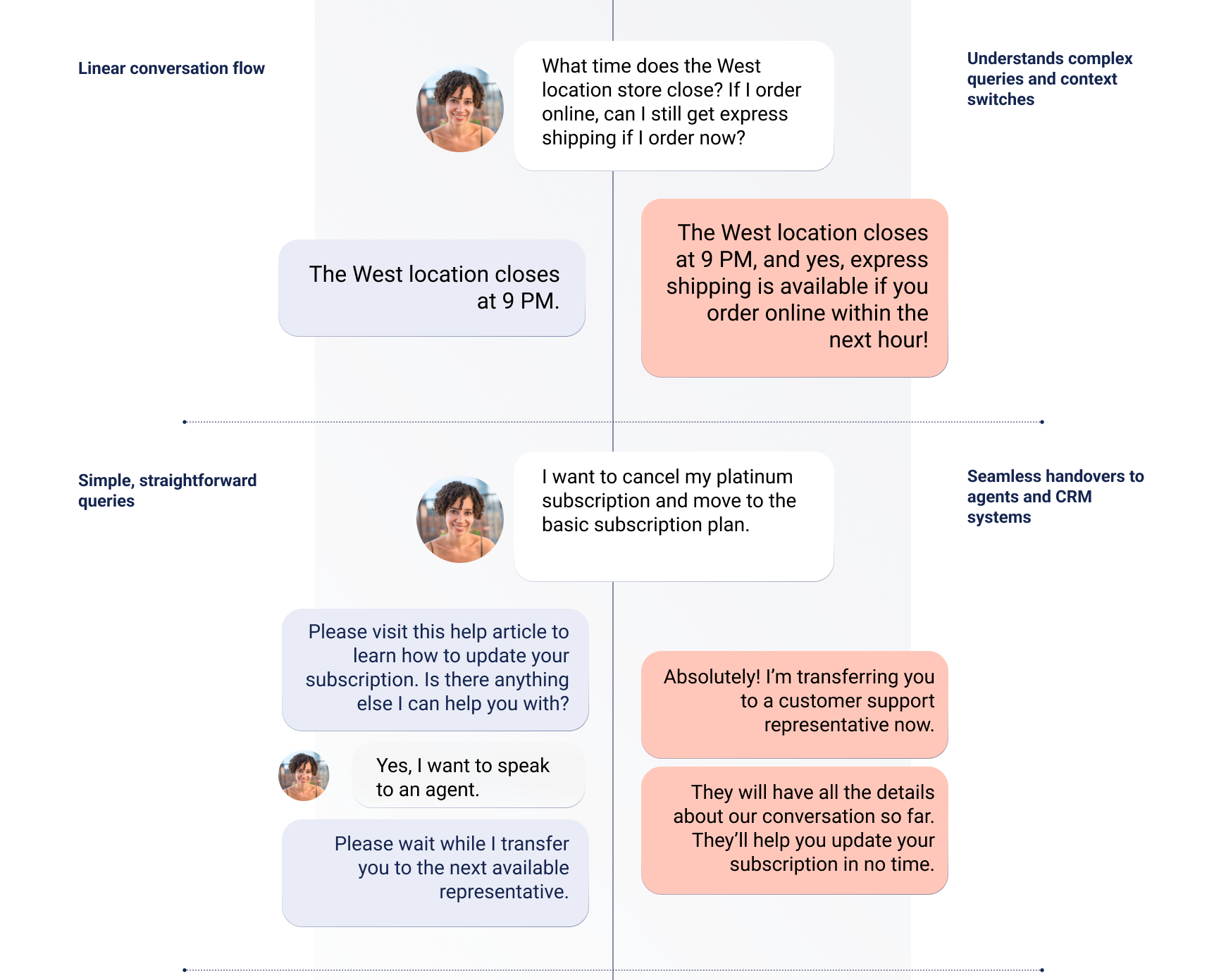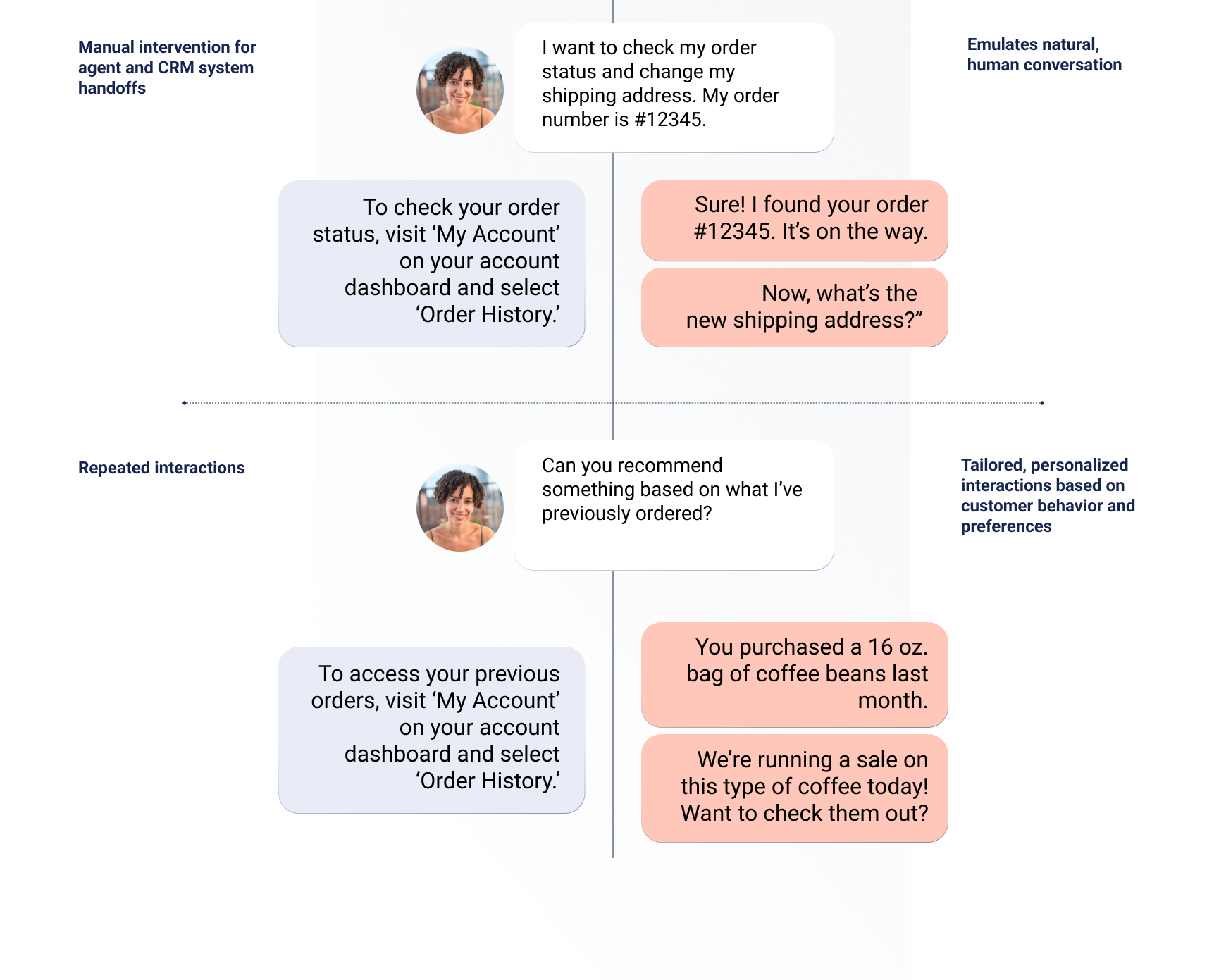Your Genesys Blog Subscription has been confirmed!
Please add genesys@email.genesys.com to your safe sender list to ensure you receive the weekly blog notifications.
Subscribe to our free newsletter and get blog updates in your inbox
Don't Show This Again.

With customer care volumes increasing and agent attrition already nearing 40%, these trends are creating a snowball effect in contact centres that can negatively impact customer experience and reduce revenue.
To address this challenge, businesses turn to bots to fill the gaps. But while traditional chatbots have been the standard solution for boosting self-service capabilities, they were designed for more limited purposes. Bots are predefined with a specific task and offer limited flexibility.
They can’t handle ambiguity like a human can, converse on a particular topic or personalise information in a way that’s unique to your brand. Handing off complex queries to human agents is possible, yet without context it forces customers to repeat themselves — contributing to bad customer experiences.
Virtual agents, the next step in conversational AI, supercharge self-service by helping organisations extend their reach through context and adaptability. Instead of responding only to specific inputs, virtual agents use AI and natural language understanding to interpret customer needs in real time, dynamically adjusting responses based on conversation flow and capturing context that can also be handed off to human agents.
This enables more personalised, complex interactions than function-based chatbots. And while they work seamlessly with human agents on handoffs, they’re also trained to express empathy for your customers.
In the past, initial conversations about implementing a bot would be about its function: Should it be a chatbot or a voicebot? And then, what queries will it handle?
The next step would be to figure out the flow for the bot to manage its tasks — and then design that flow.
After all that effort, you might end up with a decent bot, but one with significant limitations. If the bot encounters a question outside its predefined script, it’s stuck. It can’t learn from new data, improve its responses over time or understand the context of a request to provide more relevant answers.
The advancements in AI technology, especially large language models (LLMs) and generative AI, have made it easier for businesses to realise the potential of virtual agents. They can adapt their responses as they learn from user behaviour and enhance personalisation and efficiency.
Let’s look at six ways that virtual agents take traditional bots to the next level — and the striking benefits your business can expect.
Virtual agents greatly expand the scope of what a traditional bot can do. The first place we see this evolution is in building intents. This used to require meticulous management of each individual utterance, with constant tuning over time. But LLMs have changed that.
It’s much simpler to define and design the steps to resolve a task, with a series of LLM-based actions in a flow that focuses on very narrow activities. This flow-based design ensures that your solution will only do as it was trained, and that training is easier or even automated.
Basically, you give a description of a task, such as “collect information” or “find an article,” and then the LLM works on it. This makes the setting of intents, the path and the flows more versatile in natural-sounding language than in the past. This versatility enables virtual agents to handle more complex interactions and even do “intent switching” — taking on a more human-like approach to handling interactions.
Let’s say that a customer asks a virtual agent a question about a product function. Once the virtual agent answers that question, the customer could have a completely new question. At that point, the virtual agent can seamlessly switch to inquiry mode — and even refer back to the original question.
The customer interacts with the virtual agent in the same way that conversations shift with humans, without specific instructions. It can also personalise its response based on the exact question — and cite the source to verify the information.
Chatbots can’t capture the context of customer interactions or perform handovers to the extent that virtual agents can. The bot handover lacks the interaction summary, background and wrap-up codes of the interaction they just completed with a customer.
After an interaction, the virtual agent chooses the appropriate next step. If a human agent needs to take over a query, the virtual agent can create a summary and pass that along as part of its escalation. This enables the agent to pick up the conversation where the virtual agent left off. The result is that customers do not need to repeat themselves, which offers a direct improvement in the customer experience.
But if the task was fully completed, the virtual agent will write a summary and tag one of your predefined wrap-up codes to the conversation — performing the same post-interaction practices that you’d expect from a human agent.
In this way, it handles several time-consuming tasks and captures insights in a consistent manner. In both cases, the virtual agent saves its details in your CRM systems so other tools, virtual agents, administrators and human agents can use them.
Traditional chatbots typically can’t access and use analytics that would reveal gaps in the customer journey throughout a lifecycle. They don’t know what information might be missing, or that they should try to find it. Virtual agents, however, can identify what’s missing in every interaction and across multiple touchpoints.
The insights provided are actionable, which differs from a traditional dashboard of metrics that require time to make sense of. Using AI-powered intent and sentiment analysis helps make the continuous improvement of the customer experience or contact centre a reality. Data can reveal common pathways taken, where customers drop off and other inefficiencies to improve for better journeys.
Through integration with CRM systems, these details enable you to optimise customer experiences by proactively determining which gaps to address that will improve service delivery.



Even with their limited capabilities, it takes a lot of work for chatbots to perform well. And that work requires technical skills, including teams of data scientists. It’s a heavy lift for specialised resources that are hard to find. And bot training requirements make it even more complex.
In contrast, virtual agents can be designed and deployed by non-specialised resources. We use a visual, no-code flow builder powered by generative AI, LLMs and AI-enabled knowledge retrieval-augmented generation services to build intent and create virtual agents. Our drag-and-drop approach enables your teams to create workflows that are sophisticated, adaptive and scalable. Plus, you can use common language sentences in your flows versus very specifically worded and inflexible instructions.
Most importantly, you can pull from the conversations of your top agents and let AI build an entire flow based on that — saving significant time and ensuring that your most successful conversations can be replicated in future interactions with human and virtual agents.
Virtual agents eliminate the need to build bot flows from scratch because the flows generated for virtual agents are reusable across all Genesys Cloud™ AI solutions, including Genesys Cloud Agent Copilot. There’s no need to recreate flows for different purposes or types of digital support. This increases ROI by simplifying maintenance and using fewer resources to efficiently scale and optimise interactions.
Genesys has decades of experience in solving issues specific to contact centres — across industries. That expertise has enabled us to use the latest AI technology to design and deliver next-generation virtual agents with features you rely on as you serve customers. This is one way we differ from vendors who offer general-purpose virtual agents that aren’t specifically for contact centres.
Reusability is possible because our virtual agents keep humans in the loop. They seamlessly escalate complex issues to human agents, providing context from current and previous interactions. They also enable real-time human oversight, ensuring that AI-generated responses are accurate and compliant. Because there’s always a human in the loop, it ensures that data is clean and secure for reuse.
Over time, you’ll continue gaining ROI because your data doesn’t require a constant check on whether processes are good, data is accurate or you’re performing well. We’ve built those checks for you, embedded within the virtual agent.
Some companies launch AI initiatives in-house, such as building their own custom GPTs, assuming their own expertise will translate into cost savings. While building custom GPTs for business use offers flexibility, it can introduce significant risks. Data security and privacy issues are major concerns, in part because of many instances of AI going rogue without proper guardrails.
According to McKinsey, generative AI is expected to substantially increase labour productivity across the economy. By automating tasks, improving the quality and complexity of responses, and eliminating the need for continual updates, virtual agents can contribute to an uptick in productivity and ROI for your contact centre. But even they have limitations.
For example, custom models may generate inaccurate or biased responses, impacting customer trust. And there are ethical risks with unintended or inappropriate outputs or hallucinations.
Genesys takes a hybrid approach to virtual agents, using the best of both worlds from traditional rule-based chatbots and GPT chatbots. Generative AI is infused at each step, but the tasks are still defined in a flow. This reduces risk and keeps the AI on task, protecting business and customer data as it’s being accessed, analysed and shared.
That critical need drives our AI ethics approach and protocols. These protocols cover data used by all our products versus data protection that has been designed only for a specific solution.
Genesys also trains its embedded models with curated, trusted data across multiple industries, languages, use cases, dimensions and more. We incorporate privacy design principles during development. These guardrails protect the individual’s right to privacy from the outset and we don’t do add-ons after development.
This transformative leap from traditional chatbots to virtual agents is powerful and flexible, yet it’s easy to achieve value quickly. Their ability to seamlessly integrate with existing bot flows, handle complex interactions and provide deep visibility into customer journeys makes them a powerful tool for enhancing customer experiences.
With robust data security measures and ethical AI standards in place, Genesys allows you to quickly take advantage of virtual agents and do so with secure practices already in place.
See how much more you can accomplish with a Genesys Virtual Agent.
Subscribe to our free newsletter and get the Genesys blog updates in your inbox.
Related capabilities: